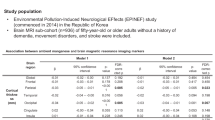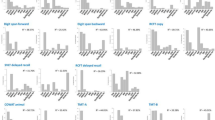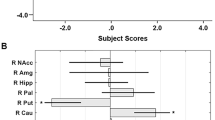Abstract
The influence of organic brain changes on the development of depression in the elderly is uncertain. Cross-sectional studies, most often from clinical samples, report associations with brain atrophy and cerebrovascular disease, while longitudinal population studies have given mixed results. Our aim was to investigate whether cortical atrophy and white matter lesions (WMLs) on computed tomography (CT) predict occurrence of depression in the elderly. This is a prospective population-based study with 5-year follow-up. The baseline sample included 525 elderly subjects, aged 70–86 years, without dementia or major depression, with a score on the Mini-Mental State Examination above 25, and without dementia at follow-up. Cortical atrophy and WMLs were evaluated at baseline using CT. The main outcome measure was development of major or minor depression at follow-up according to Diagnostic and Statistical Manual of Mental Disorders, fourth edition, as evaluated using neuropsychiatric examinations and hospital discharge registers. Logistic regression was used to estimate risk. Over the period of 5 years, 20 individuals developed major and 63 minor depression. Presence of temporal lobe atrophy (odds ratio (OR)=2.81, 95% confidence interval (CI) 1.04–7.62) and moderate-to-severe WMLs (OR=3.21, 95% CI 1.00–10.26) independently predicted major, but not minor, depression after controlling for various confounders. Other brain changes did not predict occurrence of depression. Our findings suggest that temporal lobe atrophy and WMLs represent relatively independent and complementary pathways to major depression in the elderly. This may have implications for prevention, as both neurodegeneration and cerebrovascular disease have been related to preventable factors.
Similar content being viewed by others
Log in or create a free account to read this content
Gain free access to this article, as well as selected content from this journal and more on nature.com
or
References
Alexopoulos GS, Meyers BS, Young RC, Campbell S, Silbersweig D, Charlson M (1997). ‘Vascular depression’. hypothesis. Arch Gen Psychiatry 54: 915–922.
Almeida OP, Burton EJ, Ferrier N, McKeith IG, O'Brien JT (2003). Depression with late onset is associated with right frontal lobe atrophy. Psychol Med 33: 675–681.
American Psychiatric Association (1987). Diagnostic and Statistical Manual of Mental Disorders, 3rd edn, revised American Psychiatric Association: Washington, DC.
American Psychiatric Association (1994). Diagnostic and Statistical Manual of Mental Disorders, 4th edn American Psychiatric Press: Washington, DC.
Asberg M, Montgomery SA, Perris C, Schalling D, Sedvall G (1978). A comprehensive psychopathological rating scale. Acta Psychiatr Scand Suppl 57: 5–27.
Aston C, Jiang L, Sokolov BP (2005). Transcriptional profiling reveals evidence for signaling and oligodendroglial abnormalities in the temporal cortex from patients with major depressive disorder. Mol Psychiatry 10: 309–322.
Beauregard M, Leroux JM, Bergman S, Arzoumanian Y, Beaudoin G, Bourgouin P et al (1998). The functional neuroanatomy of major depression: an fMRI study using an emotional activation paradigm. Neuroreport 9: 3253–3258.
Beekman AT, Deeg DJ, van Tilburg T, Smit JH, Hooijer C, van Tilburg W (1995). Major and minor depression in later life: a study of prevalence and risk factors. J Affect Disord 36: 65–75.
Bengtsson C, Blohme G, Hallberg L, Hallstrom T, Isaksson B, Korsan-Bengtsen K et al (1973). The study of women in Gothenburg 1968–1969—a population study. General design, purpose and sampling results. Acta Med Scand 193: 311–318.
De Leon MJ, Ferris SH, George AE, Reisberg B, Kricheff II, Gershon S (1980). Computed tomography evaluations of brain-behavior relationships in senile dementia of the Alzheimer's type. Neurobiol Aging 1: 69–79.
Djernes JK (2006). Prevalence and predictors of depression in populations of elderly: a review. Acta Psychiatr Scand 113: 372–387.
Dolan RJ, Calloway SP, Thacker PF, Mann AH (1986). The cerebral cortical appearance in depressed subjects. Psychol Med 16: 775–779.
Dotson VM, Davatzikos C, Kraut MA, Resnick SM (2009). Depressive symptoms and brain volumes in older adults: a longitudinal magnetic resonance imaging study. J Psychiatry Neurosci 34: 367–375.
Drevets WC, Price JL, Furey ML (2008). Brain structural and functional abnormalities in mood disorders: implications for neurocircuitry models of depression. Brain Struct Funct 213: 93–118.
Folstein MF, Folstein SE, McHugh PR (1975). ‘Mini-mental state’. A practical method for grading the cognitive state of patients for the clinician. J Psychiatr Res 12: 189–198.
Frisoni GB (2001). Structural imaging in the clinical diagnosis of Alzheimer's disease: problems and tools. J Neurol Neurosurg Psychiatry 70: 711–718.
Godin O, Dufouil C, Maillard P, Delcroix N, Mazoyer B, Crivello F et al (2008). White matter lesions as a predictor of depression in the elderly: the 3C-Dijon study. Biol Psychiatry 63: 663–669.
Greenwald BS, Kramer-Ginsberg E, Krishnan KR, Ashtari M, Auerbach C, Patel M (1998). Neuroanatomic localization of magnetic resonance imaging signal hyperintensities in geriatric depression. Stroke 29: 613–617.
Guo X, Waern M, Sjogren K, Lissner L, Bengtsson C, Bjorkelund C et al (2007). Midlife respiratory function and Incidence of Alzheimer's disease: a 29-year longitudinal study in women. Neurobiol Aging 28: 343–350.
Gustafson D, Lissner L, Bengtsson C, Bjorkelund C, Skoog I (2004). A 24-year follow-up of body mass index and cerebral atrophy. Neurology 63: 1876–1881.
Hercher C, Turecki G, Mechawar N (2009). Through the looking glass: examining neuroanatomical evidence for cellular alterations in major depression. J Psychiatr Res 43: 947–961.
Ikram MA, Luijendijk HJ, Vernooij MW, Hofman A, Niessen WJ, van der Lugt A et al (2010). Vascular brain disease and depression in the elderly. Epidemiology 21: 78–81.
Khundakar AA, Thomas AJ (2009). Morphometric changes in early- and late-life major depressive disorder: evidence from postmortem studies. Int Psychogeriatr 21: 844–854.
Kumar A, Bilker W, Jin Z, Udupa J (2000). Atrophy and high intensity lesions: complementary neurobiological mechanisms in late-life major depression. Neuropsychopharmacology 22: 264–274.
Kumar A, Jin Z, Bilker W, Udupa J, Gottlieb G (1998). Late-onset minor and major depression: early evidence for common neuroanatomical substrates detected by using MRI. Proc Natl Acad Sci USA 95: 7654–7658.
Kumar A, Mintz J, Bilker W, Gottlieb G (2002). Autonomous neurobiological pathways to late-life major depressive disorder: clinical and pathophysiological implications. Neuropsychopharmacology 26: 229–236.
Lopez OL, Becker JT, Jungreis CA, Rezek D, Estol C, Boller F et al (1995). Computed tomography--but not magnetic resonance imaging--identified periventricular white-matter lesions predict symptomatic cerebrovascular disease in probable Alzheimer's disease. Arch Neurol 52: 659–664.
Lucassen PJ, Fuchs E, Czeh B (2004). Antidepressant treatment with tianeptine reduces apoptosis in the hippocampal dentate gyrus and temporal cortex. Biol Psychiatry 55: 789–796.
Lupien SJ, de Leon M, de Santi S, Convit A, Tarshish C, Nair NP et al (1998). Cortisol levels during human aging predict hippocampal atrophy and memory deficits. Nat Neurosci 1: 69–73.
Palsson S, Skoog I (1997). The epidemiology of affective disorders in the elderly: a review. Int Clin Psychopharmacol 12: S3–13.
Pantoni L, Garcia JH (1997). Pathogenesis of leukoaraiosis: a review. Stroke 28: 652–659.
Pittenger C, Duman RS (2008). Stress, depression, and neuroplasticity: a convergence of mechanisms. Neuropsychopharmacology 33: 88–109.
Price JL, Drevets WC (2010). Neurocircuitry of mood disorders. Neuropsychopharmacology 35: 192–216.
Rabins PV, Pearlson GD, Aylward E, Kumar AJ, Dowell K (1991). Cortical magnetic resonance imaging changes in elderly inpatients with major depression. Am J Psychiatry 148: 617–620.
Rainer MK, Mucke HA, Zehetmayer S, Krampla W, Kuselbauer T, Weissgram S et al (2006). Data from the VITA Study do not support the concept of vascular depression. Am J Geriatr Psychiatry 14: 531–537.
Ressler KJ, Mayberg HS (2007). Targeting abnormal neural circuits in mood and anxiety disorders: from the laboratory to the clinic. Nat Neurosci 10: 1116–1124.
Schweitzer I, Tuckwell V, Ames D, O'Brien J (2001). Structural neuroimaging studies in late-life depression: a review. World J Biol Psychiatry 2: 83–88.
Shah PJ, Ebmeier KP, Glabus MF, Goodwin GM (1998). Cortical grey matter reductions associated with treatment-resistant chronic unipolar depression. Controlled magnetic resonance imaging study. Br J Psychiatry 172: 527–532.
Sheehan DV, Lecrubier Y, Sheehan KH, Amorim P, Janavs J, Weiller E et al (1998). The Mini-International Neuropsychiatric Interview (M.I.N.I.): the development and validation of a structured diagnostic psychiatric interview for DSM-IV and ICD-10. J Clin Psychiatry 59 (Suppl 20): 22–33; quiz 34–57.
Simoni M, Pantoni L, Pracucci G, Palmertz B, Guo X, Gustafson D et al (2008). Prevalence of CT-detected cerebral abnormalities in an elderly Swedish population sample. Acta Neurol Scand 118: 260–267.
Skoog I (2004). Psychiatric epidemiology of old age: the H70 study--the NAPE lecture 2003. Acta Psychiatr Scand 109: 4–18.
Skoog I, Nilsson L, Palmertz B, Andreasson LA, Svanborg A (1993). A population-based study of dementia in 85-year-olds. N Engl J Med 328: 153–158.
Skoog I, Palmertz B, Andreasson LA (1994). The prevalence of white-matter lesions on computed tomography of the brain in demented and nondemented 85-year-olds. J Geriatr Psychiatry Neurol 7: 169–175.
Steffens DC, Krishnan KR, Crump C, Burke GL (2002). Cerebrovascular disease and evolution of depressive symptoms in the cardiovascular health study. Stroke 33: 1636–1644.
Teodorczuk A, O'Brien JT, Firbank MJ, Pantoni L, Poggesi A, Erkinjuntti T et al (2007). White matter changes and late-life depressive symptoms: longitudinal study. Br J Psychiatry 191: 212–217.
Wahlund LO, Julin P, Johansson SE, Scheltens P (2000). Visual rating and volumetry of the medial temporal lobe on magnetic resonance imaging in dementia: a comparative study. J Neurol Neurosurg Psychiatry 69: 630–635.
van der Laan NC, Schimmel A, Heeren TJ (2005). The applicability and the inter-rater reliability of the Comprehensive Psychopathological Rating Scale in an elderly clinical population. Int J Geriatr Psychiatry 20: 35–40.
Versluis CE, van der Mast RC, van Buchem MA, Bollen EL, Blauw GJ, Eekhof JA et al (2006). Progression of cerebral white matter lesions is not associated with development of depressive symptoms in elderly subjects at risk of cardiovascular disease: The PROSPER Study. Int J Geriatr Psychiatry 21: 375–381.
World Health Organization (1993). The ICD-10 Classification of Mental and Behavioural Disorders: Diagnostic Criteria for Research. World Health Organization: Geneva.
Wurthmann C, Bogerts B, Falkai P (1995). Brain morphology assessed by computed tomography in patients with geriatric depression, patients with degenerative dementia, and normal control subjects. Psychiatry Res 61: 103–111.
Acknowledgements
We thank Tomas Marlow and Kristoffer Bäckman for statistical assistance, both at the Neuropsychiatric Epidemiology Unit, University of Gothenburg, Sweden. This study was funded by grants from the Swedish Research Council (No. 11267, 2005–8460, 825–2007–7462), the Swedish Council for Working Life and Social Research (No. 2001–2835, 2001–2646, 2003–0234, 2004–0150, 2006–0020, 2006–1506, 2004–0145, 2006–0596, 2008–1111, 2008–1229), The Bank of Sweden Tercentenary Foundation, the Alzheimer's Association Zenith Award (ZEN–01–3151), the Alzheimer's Association Stephanie B. Overstreet Scholars (IIRG–00–2159), the Swedish Brain Power, Sylwans stiftelse, Söderström Königska, Fredrik och Ingrid Thurings stiftelse, Selma Anderssons stiftelse and the EU FP7 project LipiDiDiet (Grant agreement no. 211696). The funders had no role in the planning of the study or interpretation of the results.
Author information
Authors and Affiliations
Corresponding author
Ethics declarations
Competing interests
DRG has received honoraria from the Albuquerque Area Indian Health Board and Shire Pharmaceutical, and receives research support from the NIH (NIA 5R03AG026098 (PI)) and the Swedish Research Council. LP serves on the editorial boards of Acta Neurologica Scandinavica and International Journal of Alzheimer Disease. IS has served on scientific advisory boards for Pfizer and AstraZeneca; has served on an editorial advisory board for International Psychogeriatrics; receives royalties from publishing Alzheimers sjukdom och andra kognitiva sjukdomar (English title: Alzheimer's Disease and Other Cognitive Disorders (Liber 2003)); serves on speakers' bureaus for Shire plc, Janssen-Cilag, Pfizer, Novartis, and Esai; and has received research support from the Swedish Research Council, the Alzheimer's Association, and the Bank of Sweden Tercentenary Foundation. The authors PJO, MS, SÖ, and XG report no biomedical financial interests or potential conflicts of interest.
Rights and permissions
About this article
Cite this article
Olesen, P., Gustafson, D., Simoni, M. et al. Temporal Lobe Atrophy and White Matter Lesions are Related to Major Depression over 5 years in the Elderly. Neuropsychopharmacol 35, 2638–2645 (2010). https://doi.org/10.1038/npp.2010.176
Received:
Revised:
Accepted:
Published:
Issue date:
DOI: https://doi.org/10.1038/npp.2010.176
Keywords
This article is cited by
-
Prospective associations of exercise and depressive symptoms in older adults: the role of apolipoprotein E4
Quality of Life Research (2017)
-
Vascular depression consensus report – a critical update
BMC Medicine (2016)
-
Prevalence and symptoms of intracranial arachnoid cysts: a population-based study
Journal of Neurology (2016)
-
An exploration of the dynamic longitudinal relationship between mental health and alcohol consumption: a prospective cohort study
BMC Medicine (2014)
-
New insights into the cardiovascular risk of migraine and the role of white matter hyperintensities: is gold all that glitters?
The Journal of Headache and Pain (2013)



